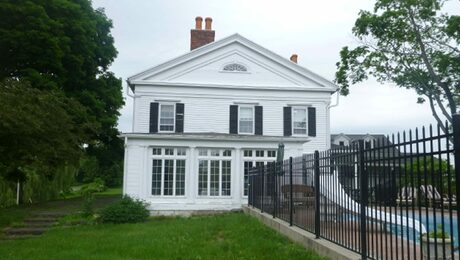I am currently getting ready to replace a rotted sill (about 3-4 feet to either side of a corner. The house was built @1870. I have been doing construction and remodeling for 25 years and have never run into this particular situation: The stud bays are infilled with mortared in place brick. I have come across the occasional brick in a stud bay, but not where it was clearly infilled on purpose. I have one of the bays open about 3-4 feet up from the sill, so it goes at least that far. It continues under a window so doesn’t seem to be an old fireplace. Could it have been intended to be some sort of weather barrier? Anyone run into this before?
Discussion Forum
Discussion Forum
Up Next
Video Shorts
Featured Story

Listeners write in about attics, foundations, and dodgy electrical devices. They ask questions about trusses, wet ceilings and siding installs.
Featured Video
How to Install Cable Rail Around Wood-Post CornersHighlights
"I have learned so much thanks to the searchable articles on the FHB website. I can confidently say that I expect to be a life-long subscriber." - M.K.














Replies
I ran into it once on a late 1800's farmhouse.
We were doing a total bathroom gut, and the stud bays were bricked and mortared from sill to top plate, but only on the south side. I had guessed maybe it was an early version of thermal mass.
Bowz
they considered it thermal mass and insulation back then
Welcome to the
Taunton University of Knowledge FHB Campus at Breaktime.
where ...
Excellence is its own reward!
It made the walls more airtight, stopped convection in the wall cavity and added some R value. Used a fair bit in Ontario. Have only found it in one very old house in the Maritimes. They called it brick "noggin"
thanks for the replies. I guess that's more or less what I thought, but it's nice to get some confirmation.
My 1880 house in Prov RI has brick in the side walls of the house. The front and back walls do not have the bricks. The internal walls have a single layer of brick. Also the joist space over the main beam is bricked as well.
I was told by a local contractor it was fire prevention, which sounds accurate for my case, with neighboor houses closely spaced side by side.
I'm sure it cuts down on the air leakage and definitely adds thermal mass (not sure if that's good). A quick googling finds that brick has a darn low R value equivalent to 1/2 Plywood.
It begs the question why didn't they just put up a brick exterior though!
splat
I think you will finfd that the nogging brick is really soft, of low quality & not fired very hard...the brickyard's "seconds"?
To say that the brick was soft is an understatement. In the process of removing the rotted sill, several bricks fell out. These bricks we simply set off to the side. Overnight we had a light rain and the next morning they were completely crumbled. We found if you picked up a small pile and worked it with your hands for a minute you could turn it back into a wad of soft clay.
sounds like thy weren't fired...Life is not a journey to the grave with the intention of arriving safely in a pretty and well preserved body, but rather to skid in broadside, thoroughly used up, totally worn out, and loudly proclaiming<!----><!----><!---->
WOW!!! What a Ride!<!----><!---->
Forget the primal scream, just ROAR!!!
>>>>>>>>>>>>>>>>sounds like thy weren't fired...From what I've seen, they were fired, but not much. Looks like they used the ones farthest away from the heat.
Its never too late to be up to date.
http://grantlogan.net/
so would they be the bargin basement bricks because of where they're at....Life is not a journey to the grave with the intention of arriving safely in a pretty and well preserved body, but rather to skid in broadside, thoroughly used up, totally worn out, and loudly proclaiming<!----><!----><!---->
WOW!!! What a Ride!<!----><!---->
Forget the primal scream, just ROAR!!!
I heard this was done for fire-blocking. Might have worked if it was relatively airtight.
What they did not understand then is that it was not the fire-resistance of the blocking material but instead the airtightness of it that was most important.
Of course the problem is that brick is like a sponge, so if it starts getting wet it is going to promote rot. Perhaps it contributed to your sill problem.
Pretty common in Southern Ny state, New Jersey, etc. - anywhere clay soil made brick-making attractive.
1760's house I lived in in NJ had bricks between the floor joists, too, between 1st & 2nd floor.
That house had been moved, bricks & all, in the 1930's.